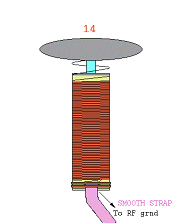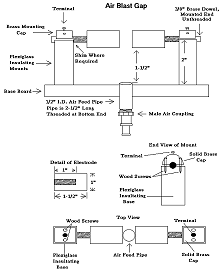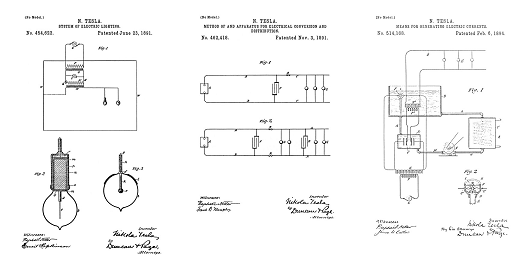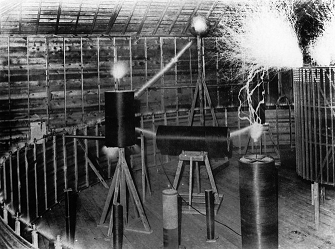Tesla Coil Primary Design

High Performance Tesla Coils

Mirror of http://amasci.com/tesla/primary.txt
Quoting "Lima, David"
>>Thus far I have not been able to understand the benefits and differences between cylindrical, flat, and saucer shaped primaries, Do you have any FAQs or text on this? Or if not maybe suggest a good book?
Man, until I write mine there is simply no real good books out there. I have a rather extensive library on the subject and I can find a section in one book, a chapter in another, but not one single reference that has any real dirt on primary coil designs and characteristics. The standard line is "wind a few turns of heavy conductor".
So let's discuss awhile and see if I can put this in fuller perspective. The primary coil design and construction is critical to a well balanced and efficient Tesla coil system.
First lets talk about the actual conductor. The Tank circuit pulse oscillates with very heavy RF current. This energy exhibits "skin effect" in that the electrical current does not flow through the conductor as much as over it. Penetration has been calculated as only being a few mils (.001 inch = 1 mil). The best conductor for this type of electrical energy is a smooth flat strap with a few mils of silver plating. The problem with flat strap primaries is that the high voltage promotes corona loss from the thin edges, and this loss can be significant. The sharp edge also provides a jumping off spot for arcs to strike the secondary when the secondaries are "overcoupled" (more on this later). One way around this is to use a bar instead of a strap. The bar can have the thin edges rounded to reduce corona losses and flashover, but it is not an efficient use of conductor.
Another conductor of choice is thin wall copper tubing. This has many advantages. The thin wall tubing is an excellent conductor for tank circuit energy, and it is available in a wide variety of outside diameters. The smooth rounded surface reduces corona loss. I use the thin wall soft copper refrigerator tubing.
Heavy Litz wire would work well.
Conductors to avoid would be solid wire, braided strap, stranded wire that has a "twist" in the conductor (parallel stranded is OK).
The next aspect of primaries is the size and shape. In the past many designers have advocated small primaries consisting of five or so total available turns, and frequently tapped in at three turns or less. This line of thought is derived from radio theory where the voltage gain was assumed to result from a ratio of turns transformation. We now know that this is a misconception.
The Tesla secondary is in fact an open ended resonator. While it is true that the ratio of turns transformation is responsible for some voltage gain in the secondary, the majority of voltage produced from a Tesla coil is pure resonant rise such as associated with open ended transmission line VSWR. With this understanding the importance of having a high ratio of turns between the primary and secondary is diminished, and uniform excitation of the resonator becomes a major concern.
The small five turn primary at the base of a coil does a very poor job of uniformly exciting the secondary coil. Most of the energy is forced into the bottom third of the secondary winding on these systems and these turns are unnecessarily stressed. The solution was frequently to space wind to unstress the secondary, which in turn reduced the ratio of turns transformation, which further crippled the poor design. The small primary, large capacitor, space wound secondary is a design loser. These systems are highly stressed, inefficient, and require large and expensive capacitors and transformers that are prone to high failure rates.
The solution of course is to move in the opposite direction. The primary needs more turns which cover a larger area. This means a substantially larger primary coil. Instead of a five turn primary coil tapped in at three turns, the coil needs to have fifteen turns tapped out at twelve or more turns. This primary design creates a much larger field flux which completely engulfs the secondary winding. The resulting excitation is much more uniform.
What happens next is very interesting. Because the secondary coil is uniformly excited, the secondary coil can be close wound with magnet wire without breakdowns and excessive corona losses. The close wound magnet wire secondary has a very high inductance per unit volume of coil form. When coupled to a large, high inductance primary, the resulting coil set will achieve the same ratio of turns transformation as the small primary design discussed previously. This is a "win-win" situation.
The large primary coil tunes with a much smaller (and cheaper) tank circuit capacitance which requires a smaller power supply to charge. Yet the system is able to process power more efficiently because of the large field flux and uniform excitation of the high inductance secondary. The overall RF power processing efficiency is so great that coilers who follow this design method blow away other designs by producing bigger sparks with much less input power. As an added boon, the large primary coil and high inductance secondary form a "slow-wave" system. The tank circuit operates at a lower frequency with less peak power which in turn reduces the stress on the gaps, caps, and power supplies. The gaps quench easier and I have found that the tank circuit capacitors have a much longer life. Run times are longer with a higher duty cycle. When something finally does fail, it is cheaper to replace.
So now that I hopefully have convinced everyone that large primaries and close wound high inductance secondaries are the way to go, what shape primary coil is best?
The basic primary shapes are the vertically rising helix; the flat "pancake" Archimedes spiral; and the "hybrid" inverse conical section or "saucer" coil. I do not like the coupling characteristics and the shape of the field flux produced by a vertically rising helix primary. I do not recommend using them unless you are building Tesla Magnifier systems. For small to medium 1/4 wave coils I would recommend the "saucer" primary. As I mentioned earlier, I like about 15 primary turns available, and the conical section should have an angle of slope of about 30 degrees starting with the lower inside turn and rising to the outside turn. On larger coils running with higher voltage inputs and greater peak powers the best primary is going to be a flat pancake.

Image Credit: http://www.teslathon.de/stefan/tc/primcoil.htm
The reason I like these specific shapes is for their coupling characteristics, which are derived from the size and shape of the magnetic field flux they produce. A good primary coil will end up being about as wide as the secondary coil is tall. When the primary is tapped out over nine turns or so, the field flux that is generated couples in the entire secondary winding all the way to the top turn on the coil. I know this for a fact because in Tesla coil systems that are overdriven the field flux contains so much energy that it ionizes the air. Clearly visible corona maps out the field size, shape, and relative intensity.
Next we need to briefly discuss coupling and over-coupling. Coupling quite loosely is the inductive interaction between two coils. In Tesla coil systems the pulse oscillation through the primary creates a powerful magnetic field. When the gap is quenched the magnetic field collapses and the energy that was contained in the system is forced into and trapped in the secondary. If too much energy is forced into the secondary coil the resonator frequency will "split". Splitting is the formation of parasitic harmonic resonances of higher frequency in the secondary winding. Splitting is observed when the 1/4 wave voltage peaks of these parasitic harmonics break out as sparks from the middle of the winding. Sparks will jump up and down the sides of the coil. Excessive corona resulting in a visible primary/secondary field flux is another indication that the secondary coil is being overdriven. Splitting and excess corona indicate that the system is over-coupled. The cure for over-coupling is to raise the secondary coil some, which reduces the inductive interaction.
If the primary coil is not properly shaped, like a flat pancake coupled to a tall skinny secondary, then the coupling will be too loose and insufficient energy will be transferred to the secondary. There is no easy cure for this. If the primary under-couples or couples too "loosely" you have to rework the coils. This is one reason I suggest that the intended primary be designed and built with tight or "close" coupling in mind. If the primary over-couples you can then raise the secondary until the system is "critically coupled".
The one thing that did not just fall into place in the text above is the turn to turn spacing of the primary. The space between turns needs to be kept small. The largest spacing that I have required is 1/2 inch between the edges of a copper tube primary where the operating voltage was 20KVAC RMS into the tank circuit. Most primaries need no more than 1/4 to 3/8 of an inch inter-turn airspace.
If you have gotten this far, and you are serious about physically constructing a Tesla coil, Lab-Tesla hosts an extensive archive of RAW text containing information on power supplies, spark gap systems, etc.. Including instructions on how to scavenge and salvage for free and low-cost components. Please click on the link below, this text file is 600K and unedited. It is mirrored at: http://textfiles.com/science/rqmsgs_t
FidoNet Messages - 10KVA Tesla Coil - 1993


High Performance Tesla Resonator Design

High Performance Air-Blast Spark Gap

Tesla's Electrical Isochronous Oscillators

Capacitive Discharge Power Processing
Tesla's Electric Circuit Controllers

